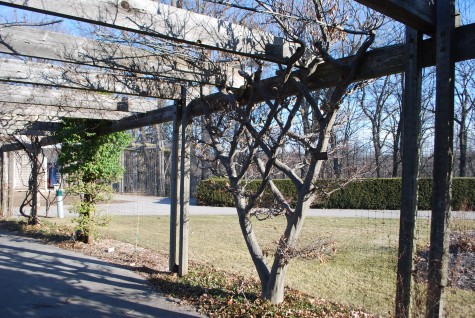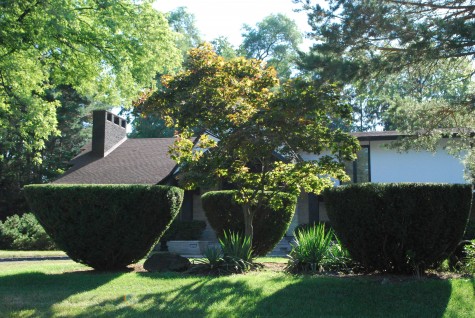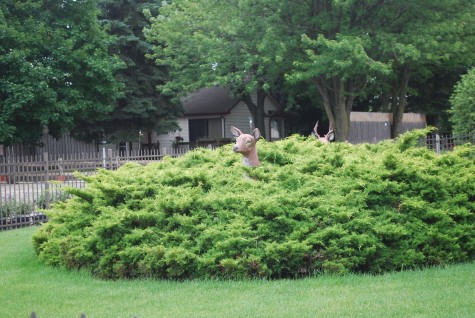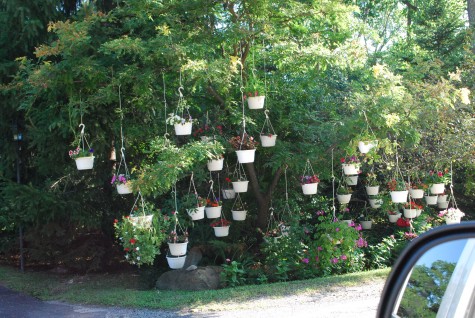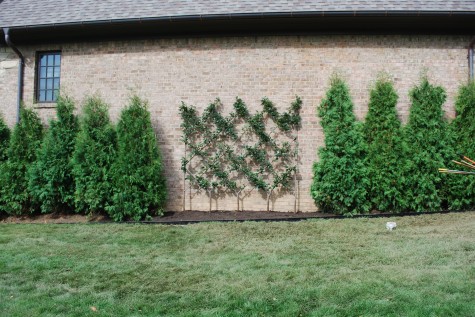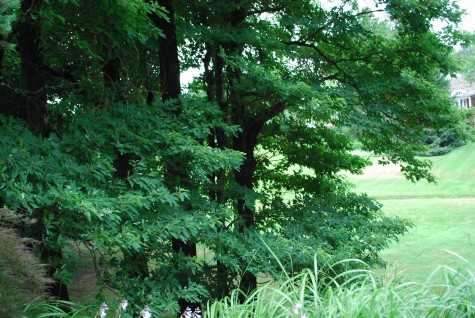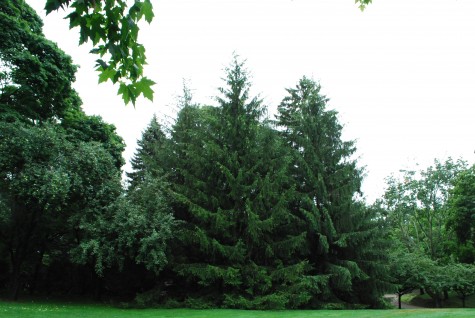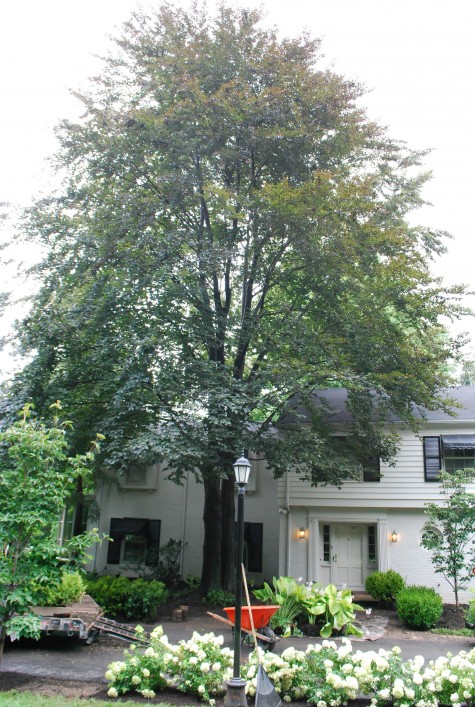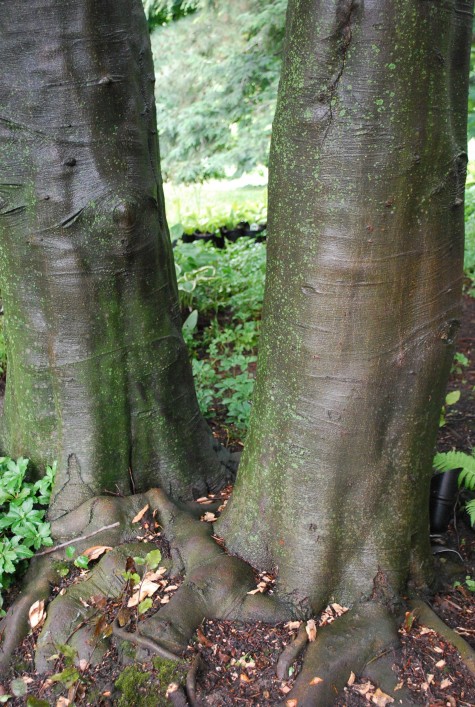Archives for July 2011
At A Glance: Eccentric
Trees For Very Shallow Spaces
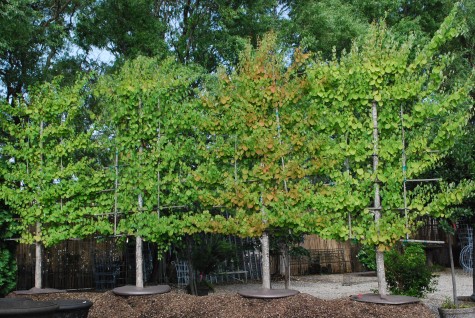 I have written about espaliered trees before. Proper pruning is an important element of good garden maintenance. But espalier-making is the intersection of the science of how things grow with the art of gardening. Interested in a little something about that history? Search the post Palmette Legendre for my short take on the practice of growing trees in two dimensions. The posts “Green Walls”, and “the 2010 espaliers” further that discussion. Given this week devoted to some thoughts about trees and the spaces they require, espaliered trees come to mind. These four old Katsura trees have been patiently trained for many years to grow wide and flat. As you can see, some of the arms have outgrown the stakes that keep them horizontal. They will continue to grow vertically, until I retie them to their training stakes. They are ready to make a flat green wall in a very narrow space.
I have written about espaliered trees before. Proper pruning is an important element of good garden maintenance. But espalier-making is the intersection of the science of how things grow with the art of gardening. Interested in a little something about that history? Search the post Palmette Legendre for my short take on the practice of growing trees in two dimensions. The posts “Green Walls”, and “the 2010 espaliers” further that discussion. Given this week devoted to some thoughts about trees and the spaces they require, espaliered trees come to mind. These four old Katsura trees have been patiently trained for many years to grow wide and flat. As you can see, some of the arms have outgrown the stakes that keep them horizontal. They will continue to grow vertically, until I retie them to their training stakes. They are ready to make a flat green wall in a very narrow space.
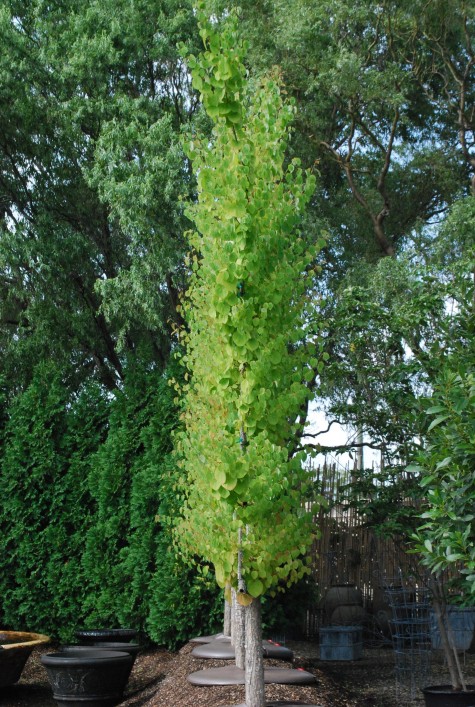 Viewed from the side, the trunks and foliage of these katsuras occupy barely 2 feet of space. The rootballs are more than twice the size of the tops. A grower in Oregon grew these incredible trees, given enormous patience, and a great love of plants. A great deal of work was needed to train these trees into this shape. Cercidiphyllum, or katsure, had a broadly oval natural shape. Changing that shape involves training from a very early age.
Viewed from the side, the trunks and foliage of these katsuras occupy barely 2 feet of space. The rootballs are more than twice the size of the tops. A grower in Oregon grew these incredible trees, given enormous patience, and a great love of plants. A great deal of work was needed to train these trees into this shape. Cercidiphyllum, or katsure, had a broadly oval natural shape. Changing that shape involves training from a very early age.
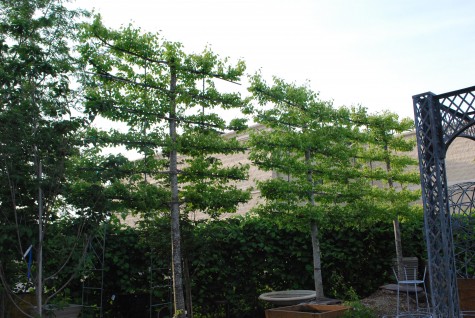 I bought old espaliered lindens from the same grower. I had to have them. I paid to dig, ball and burlap, and ship 14 espaliered trees across the country in a refrigerated truck. Nuts, yes. Think of me what you will, but these old espaliers are extraordinarily beautiful plants, and almost all of them are spoken for now. Most of the espaliers I buy are young, and of small caliper. They need a support system in order to maintain their shape. Many espaliers are grown against a wall, for this reason. These trees are old enough to be a wall. It is hard to see in this picture, but the horizontal arms are being held in place by vertical stakes. These stakes maintain a uniform distance between each arm.
I bought old espaliered lindens from the same grower. I had to have them. I paid to dig, ball and burlap, and ship 14 espaliered trees across the country in a refrigerated truck. Nuts, yes. Think of me what you will, but these old espaliers are extraordinarily beautiful plants, and almost all of them are spoken for now. Most of the espaliers I buy are young, and of small caliper. They need a support system in order to maintain their shape. Many espaliers are grown against a wall, for this reason. These trees are old enough to be a wall. It is hard to see in this picture, but the horizontal arms are being held in place by vertical stakes. These stakes maintain a uniform distance between each arm.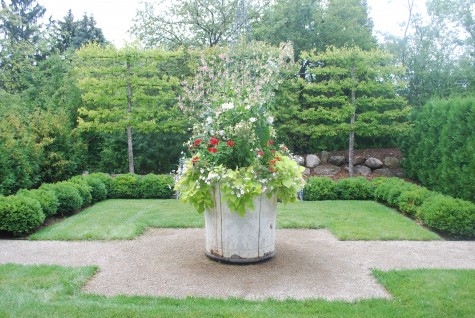 Three of the old linden espaliers got placed in a small side garden. The grade behind them rises steeply; the property line is barely 3 feet beyond the espaliers. Once the arborvitae grown, this garden will feel like a room with the sky for a ceiling. This is a garden in the process of becoming a place to be. A decision will need to be made fairly soon. If the horizontal branches are not kept pruned, the green stripes will become a green plane.
Three of the old linden espaliers got placed in a small side garden. The grade behind them rises steeply; the property line is barely 3 feet beyond the espaliers. Once the arborvitae grown, this garden will feel like a room with the sky for a ceiling. This is a garden in the process of becoming a place to be. A decision will need to be made fairly soon. If the horizontal branches are not kept pruned, the green stripes will become a green plane.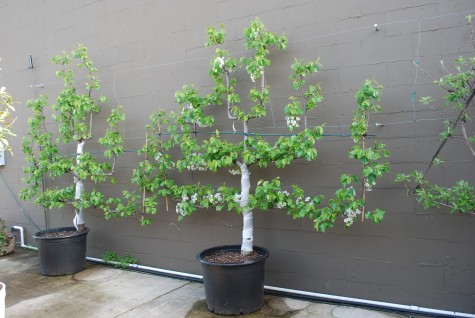 Almost any tree can be trained in two dimensions. These crabapples have been pruned in a classic candelabra form. The vertical stakes holding the arms in place are attached to wires, which are held a few inches away from the wall with bolts. This permits good air circulation on the backside of the branches.
Almost any tree can be trained in two dimensions. These crabapples have been pruned in a classic candelabra form. The vertical stakes holding the arms in place are attached to wires, which are held a few inches away from the wall with bolts. This permits good air circulation on the backside of the branches.
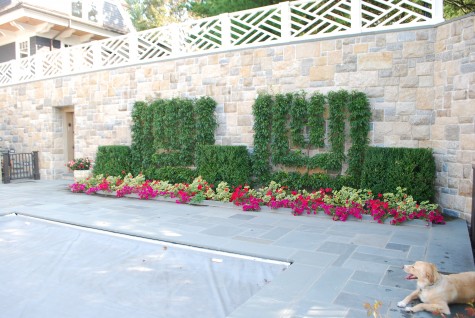 This is the third year in the ground for these crabapples. They dress up this massive stone wall without obscuring it. The total width of the bed from the wall to the bluestone terrace is 4 feet. In the absence of any green, this space would feel a little too desolate. Alternating with the espaliers-blocks of Green Mountain boxwood. They naturally grow taller than wide.
This is the third year in the ground for these crabapples. They dress up this massive stone wall without obscuring it. The total width of the bed from the wall to the bluestone terrace is 4 feet. In the absence of any green, this space would feel a little too desolate. Alternating with the espaliers-blocks of Green Mountain boxwood. They naturally grow taller than wide.
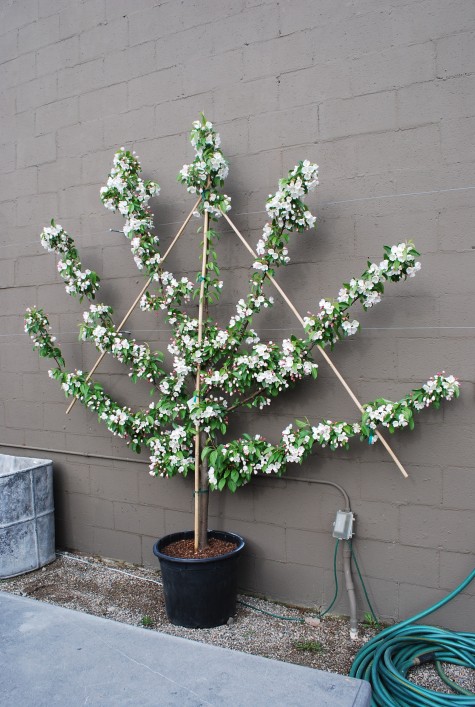 This crabapple has been trained in a fan shape. Each arm radiates out from the trunk in a symmetrical fashion. Growing an espalier in a symmetrical shape requires the selection and training of that branch which appears in exactly the right spot. I would be much better at keeping up an espalier that had been trained for a few years, than starting one from scratch.
This crabapple has been trained in a fan shape. Each arm radiates out from the trunk in a symmetrical fashion. Growing an espalier in a symmetrical shape requires the selection and training of that branch which appears in exactly the right spot. I would be much better at keeping up an espalier that had been trained for a few years, than starting one from scratch.
 This fan espalier has been trained one step further. In addition to fanning out, it has been trained to grow over the sides of the chimney. Young tree branches are flexible, and will adapt to this training. Once the twigs attain some size, the shape often becomes self-supporting. It wil be very interesting to see the shape of this tree in 10 years.
This fan espalier has been trained one step further. In addition to fanning out, it has been trained to grow over the sides of the chimney. Young tree branches are flexible, and will adapt to this training. Once the twigs attain some size, the shape often becomes self-supporting. It wil be very interesting to see the shape of this tree in 10 years.

This espalier has an entirely free form shape. Taking up little more than 2 feet on the face of this wall, it is a striking addition to this garden. The combination of the narrow wood clapboard, the espalier, and the Annabelles in bloom makes quite the picture.
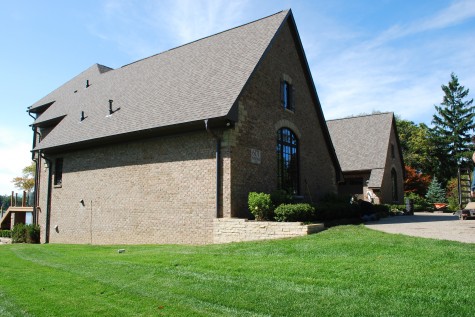 Driving up the street to this property for the first time, I was struck by how this giant bare wall seemed to be asking for something. As maintaining access to the lake was a very important issue, an espalier of some kind seemd like a good idea.
Driving up the street to this property for the first time, I was struck by how this giant bare wall seemed to be asking for something. As maintaining access to the lake was a very important issue, an espalier of some kind seemd like a good idea.
These 5 trees are trained in an espalier pattern known as a Belgian fence. When these apple trees were a single whip, 4 feet tall, they were pruned down to within a foot of the ground. When a pair of branches emerged at that cut, they were potted, and staked to create the beginning of a lattice fence. Given another 10 years, they will cover this section of wall, and provide plenty of apples. Were I a young gardener, I would make it my business to espalier something-for the fun of it now, and the beauty of it later.
Trees For Big Spaces
There are those trees that grow to an astonishing height, width, and girth. The dawn redwoods in California-they are legendary, given their enormous size and age. In Michigan, we have giant beech and maples in our climax forests. The biggest trees I have ever seen in person are in the Upper Peninsula of Michigan. Even the birch and the cedars grow to enormous size. None of these trees were in yards-they were all part of virgin forests protected by the state. Large trees need large spaces to flourish. It has been some years since I re-landscaped this property around a very large copper beech. I regret to say that it was recently cut down, and a smaller beech planted in much the same area. As I could not bear to take down a magnificent tree of this age, I am very careful about placing them in the landscape.
If you are like me, you have a small property stuffed with no end of plants. The one large Norway maple on my property influences the health and happiness of every plant within the reach of its shade and surface roots. I dislike dealing with the consequences on the ground from this tree, but it is worth the trouble. At least it was planted 30 feet away from the house-for that I am grateful. Small city lots are not so well suited for big trees-they need wide open spaces. This beautiful grove of sassafras trees is stately and elegant-and too large to capture with a camera unless I were in the yard next door. Large properties like this are ideal for big trees.
In another spot, a graceful trio of weeping Norway spruce that are so large they have become a single tree. Removing any one of the three would reveal a not so green interior. But one thing is for sure. All three have all the room in the world to grow as large as they might. Any large growing planted forced to fit into a space that is too small invariably has that tortured look. I rarely see a burning bush planted in a sufficiently large space. Every euonymus alata compacta grows to 8 by 8 feet-and faster than you think it will.
I have 8 Norway maples in my tree lawn. The tree lawn? That space between the sidewalk and the street is the tree lawn. I would guess those maples have been there 60 years or better. All of these very big and old maples are failing; every year another giant branch fails to leaf out. How so? The concrete space between the sidewalk and the street makes for roots that go round and round. Girdling roots can eventually strangle a tree. My big street trees were beyond surgical help when I moved there, I am sorry to say. I am too embarassed to publish a picture of my trees. I would rather you see this old maple, growing vigorously.
 This beautiful oak tree is in a confined space; a driveway sunken below grade makes it impossible to see the drive from the street. That circle is probably 45 feet across. Whatever the space, it is enough to keep the tree happy and healthy.
This beautiful oak tree is in a confined space; a driveway sunken below grade makes it impossible to see the drive from the street. That circle is probably 45 feet across. Whatever the space, it is enough to keep the tree happy and healthy.
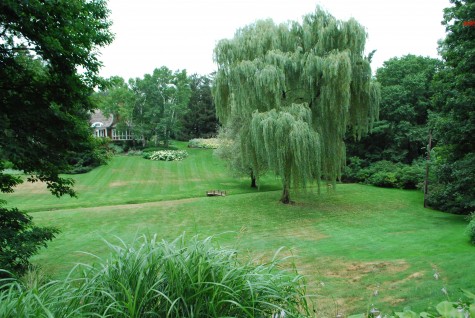 Weeping willow trees endure all sorts of bad press. They are weak wooded and are always dropping branches. But they have a great beauty about them, grown to stand alone in a large space.
Weeping willow trees endure all sorts of bad press. They are weak wooded and are always dropping branches. But they have a great beauty about them, grown to stand alone in a large space.
 Trees and lawn spaces can make for very powerful and evocative landscapes. People in this neighborhood have resisted paving the roads, even though the issue comes up for review every few years. My client has beautifully peaceful views from her large property to the one adjacent. The country style gravel road makes the landscape appear all the more bucolic.
Trees and lawn spaces can make for very powerful and evocative landscapes. People in this neighborhood have resisted paving the roads, even though the issue comes up for review every few years. My client has beautifully peaceful views from her large property to the one adjacent. The country style gravel road makes the landscape appear all the more bucolic.
This landscape is entirely dominated by a double trunked green beech of astonishing size. Part of the landscape renovation will involve some changes to the irrigation system, as well as a plant palette that will cope with the shade cast by the beech. I am sure when the tree was planted it was quite small by comparison to day. Though it is badly placed, it is much too beautiful to take down. So we will build on it.
Trees For Tight Places
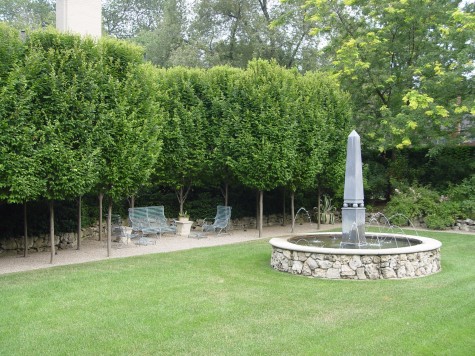
Any landscape is predicated on a finite amount of space. A property could be described by a certain amount of square footage on the ground plane. A landscape is comprised of lots of different elements, the largest of which would be the sky. Next up, the trees. I suppose a small urban property could be forested like woodland, but that assumes the gardener has only one use in mind for their landscape. Fortunately, trees come in all sizes and shapes. A number of trees have a fastigiate, or columnar form. This means just what the word implies. The foliage or needles grow naturally in a column. A tree with a restricted spread is a great choice for small gardens, for gardens that ask for screening, and for gardens asking for natural ornament. Years ago, this side garden was in full view of a neighboring house. Today all that remains of that view is a chimney. The arrangement of pairs of columnar hornbeams have created a natural pergola that is home to a shady seating area.
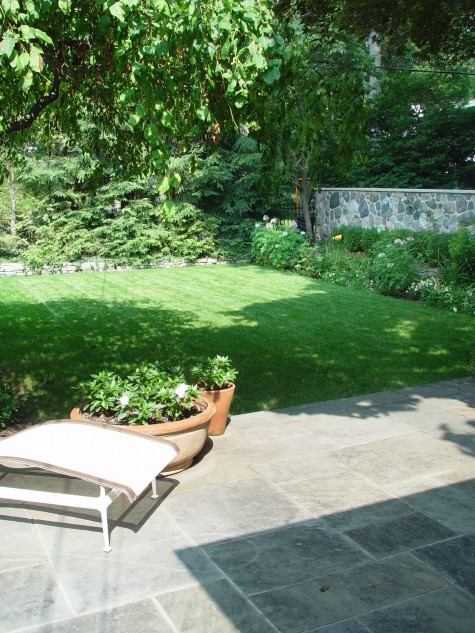 My first visit to this property immediately brought the idea of columnar trees to mind. The back yard is very small, and adjacent properties very close. The prominent feature of the yard-a beautifully constructed wall. The soil had been mounded up against the wall, and boxwood had been planted against its base. In the front of the bed, a collection of perennials. The boxwood and perennials obscured rather than featured the wall, nor could they possibly provide screening from a neighboring house. The rear yard screen of hemlocks had grown thin, and was very wide at the bottom where no screening was really needed.
My first visit to this property immediately brought the idea of columnar trees to mind. The back yard is very small, and adjacent properties very close. The prominent feature of the yard-a beautifully constructed wall. The soil had been mounded up against the wall, and boxwood had been planted against its base. In the front of the bed, a collection of perennials. The boxwood and perennials obscured rather than featured the wall, nor could they possibly provide screening from a neighboring house. The rear yard screen of hemlocks had grown thin, and was very wide at the bottom where no screening was really needed.
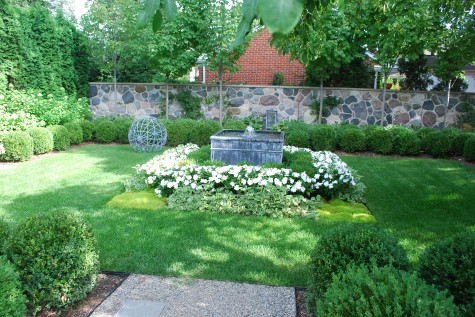 These columnar Bowhall maples will eventually completely screen the neighbor’s garage wall from view. Lowering the grade meant much more of the wall was available to view. The hemlocks were replaced with Thuja Nigra, an arborvitae that grows narrow and tall. A very small yard is now completely private, given the planting of fastigiate trees. The maples only occupy the air space; their pole-like trunks take up no room whatsoever. The arborvitae are narrow at the bottom as well as the top. This helps to make a very small space feel spacious.
These columnar Bowhall maples will eventually completely screen the neighbor’s garage wall from view. Lowering the grade meant much more of the wall was available to view. The hemlocks were replaced with Thuja Nigra, an arborvitae that grows narrow and tall. A very small yard is now completely private, given the planting of fastigiate trees. The maples only occupy the air space; their pole-like trunks take up no room whatsoever. The arborvitae are narrow at the bottom as well as the top. This helps to make a very small space feel spacious.
 This back yard sloped steeply towards the foundation of the house; water in the basement was a problem. A retaining wall permitted the soil at ground level to be graded away from the house. The top of the wall was planted with hornbeams spaced at 12 feet apart; they will grow together faster than you think. Carpinus fastigiata is naturally broadly egg shaped, but it is quite tolerant of pruning. The hydrangeas will make the wait for the trees to grow a little more tolerable. It will be interesting to see what direction the client wants to take with pruning. They have time to sort that out. The wall also gave the trees a little leg up, screening out the neighboring property.
This back yard sloped steeply towards the foundation of the house; water in the basement was a problem. A retaining wall permitted the soil at ground level to be graded away from the house. The top of the wall was planted with hornbeams spaced at 12 feet apart; they will grow together faster than you think. Carpinus fastigiata is naturally broadly egg shaped, but it is quite tolerant of pruning. The hydrangeas will make the wait for the trees to grow a little more tolerable. It will be interesting to see what direction the client wants to take with pruning. They have time to sort that out. The wall also gave the trees a little leg up, screening out the neighboring property.
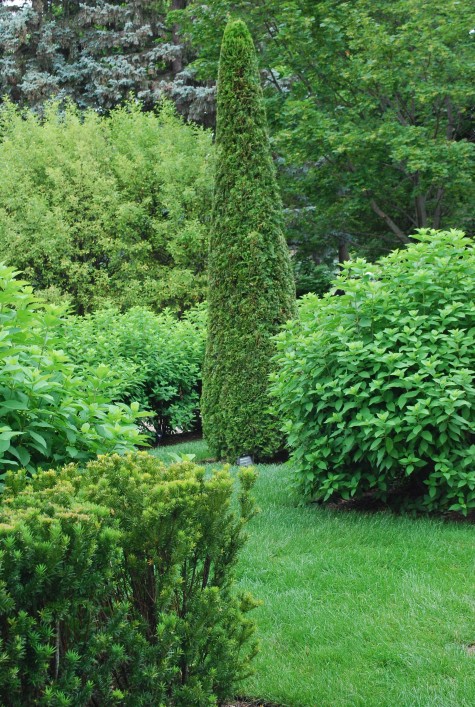 Arborvitae have a naturally columnar shape, but they also adapt quite well to closer pruning. This landscape called for a vertical element which would not shade the surrounding plants. A once yearly pruning is all it needs to keep it in shape.
Arborvitae have a naturally columnar shape, but they also adapt quite well to closer pruning. This landscape called for a vertical element which would not shade the surrounding plants. A once yearly pruning is all it needs to keep it in shape.
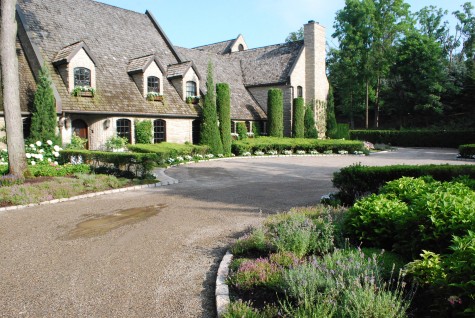 This landscape features both pruned and unpruned arborvitae. The pruned cylindrical shapes are very interesting and sculptural. Pruning any tree or evergreen should be undertaken over time. It has taken my palabin lilacs on standard 2 years to recover from the shock of my pollarding fit.
This landscape features both pruned and unpruned arborvitae. The pruned cylindrical shapes are very interesting and sculptural. Pruning any tree or evergreen should be undertaken over time. It has taken my palabin lilacs on standard 2 years to recover from the shock of my pollarding fit.
 There are those trees that are not particularly columnar by nature, but they are amenable to pruning. The hybrid magnolia “Ivory Chalice”, a cross between magnolia acuminata, and Magnolia denudata, has been priuned to stay within the confines of this very narrow space along a driveway. They have been happy here for over 10 years.
There are those trees that are not particularly columnar by nature, but they are amenable to pruning. The hybrid magnolia “Ivory Chalice”, a cross between magnolia acuminata, and Magnolia denudata, has been priuned to stay within the confines of this very narrow space along a driveway. They have been happy here for over 10 years.
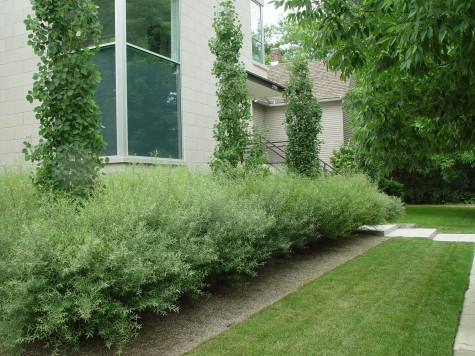 Populus tremuloides erecta , or Swedish columnar poplar, is a loosely growing columnar tree that will eventually provide some screening for the giant windows of this contemporary home. The rounded and scalloped leaves flutter in the breeze just like any other popple, and the fall color is great. This tree may occasionaly have a branch that falls out-a little pruning will put that to right. Even older trees are not much wider than 5 or 6 feet.
Populus tremuloides erecta , or Swedish columnar poplar, is a loosely growing columnar tree that will eventually provide some screening for the giant windows of this contemporary home. The rounded and scalloped leaves flutter in the breeze just like any other popple, and the fall color is great. This tree may occasionaly have a branch that falls out-a little pruning will put that to right. Even older trees are not much wider than 5 or 6 feet.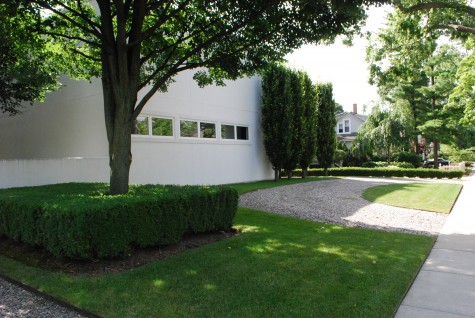
Of course the queen bee of columnar trees has to be the fastigiate European green beech. Properly cared for, as these are, they make a very strong vertical statement.
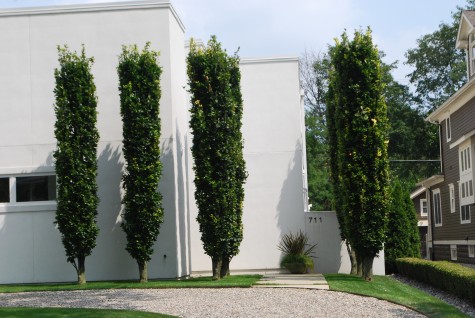 Once these trees reach the roof line of the house, they could be pruned flat. Age will only improve these fine trees.
Once these trees reach the roof line of the house, they could be pruned flat. Age will only improve these fine trees.

